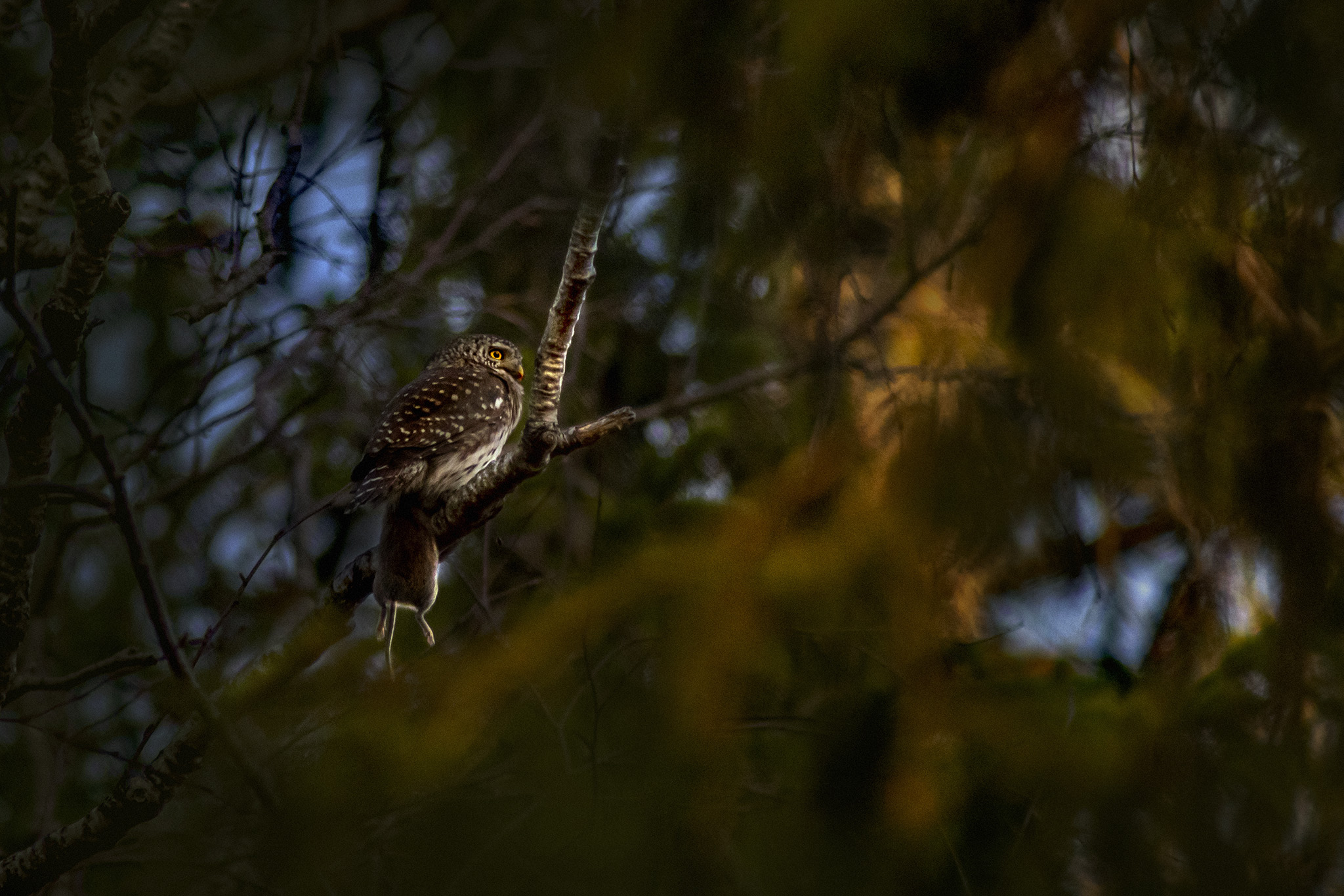Eurasian Pygmy Owl (Glaucidium passerinum)
The Eurasian Pygmy Owl is the smallest owl species in Europe, known for its petite size and bold behavior. Despite its diminutive stature, it is a skilled predator, adept at hunting prey larger than itself. Found in forested regions across the Palearctic, this owl is a fascinating species to observe.
Physical Description
- Size:
- Length: 15–19 cm (6–7.5 inches).
- Wingspan: 32–39 cm (12.5–15 inches).
- Weight: 50–80 grams (1.8–2.8 ounces).
- Plumage:
- Brown upperparts with white spots on the head and shoulders.
- Underparts are whitish with dark streaks.
- Tail is long and barred, aiding in agility during flight.
- Eyes:
- Bright yellow, characteristic of nocturnal and crepuscular birds of prey.
- Distinctive Features:
- Rounded head without ear tufts.
- A short, curved beak suitable for catching and tearing prey.
Behavior
- Hunting:
- Active during dawn and dusk (crepuscular), but can also hunt in daylight.
- Feeds primarily on small mammals (e.g., voles and mice), birds, and insects.
- Stores surplus prey in tree cavities or under loose bark, especially in winter.
- Call:
- A high-pitched, whistling “toot-toot-toot” used to mark territory and attract mates.
- Social Behavior:
- Solitary except during the breeding season.
- Territorial, with males defending their range vigorously.
Habitat
- Prefers old-growth coniferous and mixed forests with a high density of tree cavities for nesting.
- Found in boreal and montane regions across Europe and Asia, including Scandinavia, the Alps, and Siberia.
- Thrives in areas with abundant prey and nesting opportunities.
Life Cycle
- Breeding:
- Breeding season begins in late winter to early spring.
- Males attract females with their calls and offer prey as a courtship gift.
- Nesting:
- Uses natural tree cavities or old woodpecker holes.
- No additional nesting material is added.
- Eggs:
- Female lays 3–7 white eggs.
- Incubation lasts about 28–30 days, performed solely by the female.
- Chicks:
- Hatchlings are fed by the male, who hunts for the family.
- Fledge at around 30 days but remain dependent on parents for a few more weeks.
Distribution
- Found across a broad range in the Palearctic region:
- Europe: From Scandinavia and the Baltic states to the Alps and Carpathians.
- Asia: Extending through Siberia to the Pacific coast.
- Prefers altitudes ranging from lowlands in the north to mountainous regions in the south.
Conservation Status
- Classified as Least Concern by the IUCN due to its wide distribution and stable population.
- However, local populations may be affected by:
- Logging and habitat loss reducing suitable nesting sites.
- Climate change impacting prey availability and forest composition.
Ecological Role
- Predator:
- Helps regulate populations of small mammals and birds.
- Prey:
- Supports higher predators like larger owls and hawks.
Interesting Facts
- Small but Fierce:
- Known for its courage, the Eurasian Pygmy Owl often hunts prey nearly as large as itself.
- Daylight Hunter:
- Unlike many owls, it is frequently active during daylight hours, especially in winter when days are short.
- Prey Cache:
- Stores extra food in tree cavities, ensuring a steady supply during scarce periods.
- Mimicry Adaptation:
- The back of its head has feather patterns resembling eyes, deterring predators approaching from behind.
Summary
The Eurasian Pygmy Owl (Glaucidium passerinum) is a remarkable blend of cuteness and ferocity. Its adaptability to cold climates, skilled hunting abilities, and unique behaviors make it an integral part of forest ecosystems. Protecting its habitats ensures the survival of this tiny but mighty owl for future generations.
Visited 204 times, 28 visit(s) today
Views: 362
Subscribe to the newsletter:
